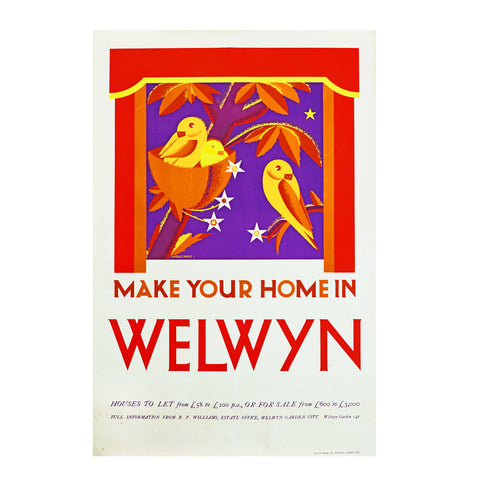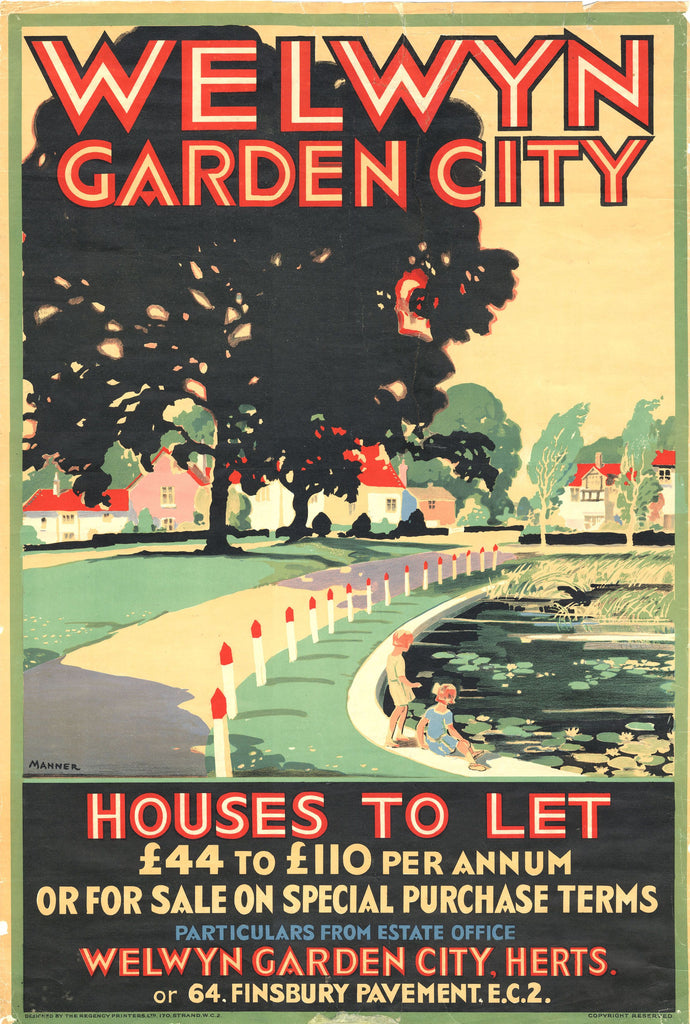The unprecedented expansion of London’s suburban hinterland in the 1920s and 30s required a new type of publicity to sell the homes and lifestyles on offer. In London Transport Posters. A Century of Art & Design (2008), I wrote about the methods used by London Underground to market the emerging Tube-fed suburbs of Golders Green, Edgware, Morden and elsewhere, and the extraordinary efforts of the Metropolitan Railway to sell ‘Metro-land’ to City commuters. But surprisingly little has been written about suburban ‘place-selling’ in other parts of the Greater London area and beyond, even when, as in the case of Welwyn, publicity matched the quality of more famous London-centred campaigns.

Situated just 20 miles north of King’s Cross in rural Hertfordshire, Welwyn Garden City was founded by Ebenezer Howard, the pioneer of the ‘garden-city’ movement. The intention was to create carefully planned new towns “designed for healthy living and industry” that would combine the benefits of the city and the countryside while avoiding the disadvantages of both. Central to this vision was the provision of high-quality homes with gardens for all classes, supported by thriving local amenities and plenty of open green spaces. Equally important, from a practical perspective, was the availability of a fast, reliable, train service to London where many of the new residents were initially expected to work.

Brochure design by Freda Beard, via WGC Heritage Trust
The development, and subsequent publicity, was managed by a Trust, Welwyn Garden City Limited, chaired by Sir Theodore Chambers with Louis de Soissons appointed as architect and town planner. The first houses were ready for occupation in 1920, with many more under construction together with community facilities and factory spaces. It was a bold project, which required extensive advertising to persuade families and businesses to relocate. During the 1920s and 30s, much of this direct marketing was done through newspaper ads and glossy brochures, but also via an impressive poster campaign that helped establish Welwyn as a thoroughly modern and desirable place to live.
From the start, the development company employed leading commercial artists to promote the new town. The well-known poster designer and artists’ agent R.P. Gossop was among the first to lend his talents to the campaign, providing illustrations for an early publicity brochure and designing a decorative poster map stressing the closeness of Welwyn to the Metropolis. Although no copy of the poster appears to have survived, Gossop reproduced the image in his 1927 publication Advertisement Design (below). The style is typical of Gossop’s contemporary poster maps for London Underground, but it’s interesting to note that both the rail and road connections to central London are prominently marked in anticipation of the growing importance of the motor car. Interesting, too, that Welwyn is depicted as a beaming sun in contrast to the smoky factories and terraced streets of ‘old’ London.

The contrast was even more explicitly made in a full-page press ad drawn by Ernest Wallcousins, which charts the idealised progression from working in ‘the smoke’ and living in the suburbs to both living AND working ‘in the sun at Welwyn Garden City’. From supporting literature it’s clear that this ideal was the ultimate goal of the town’s planners, although posters continued to stress the convenience of London for commuters.

Few of the posters from this period show the actual houses for sale or rent. Instead, the focus is on Welwyn as a healthier, but nonetheless up to date, alternative to London living. The emphasis on modernity and vitality is well illustrated by a brace of posters from about 1925 by Eric Fraser and Freda Beard. The former shows a fashionable couple dancing under Deco-ish lighting at a Welwyn nightspot, with the closeness of revitalising nature artfully represented in the background. Similarly, Beard’s depiction of a tanned young woman collecting flowers in the sunshine suggests both youthfulness and the realisation of a better life. It comes as no surprise to find that both these posters were specifically designed for display at London railway and Underground stations.


While most of the posters were paid for by Welwyn Garden City Limited, rail and coach operators were quick to cash in on the opportunity to sell daytrips and season tickets to the new residents and began to commission their own designs. One of the best, by Gregory Brown, advertised ‘the country around Welwyn’ for the London & North Eastern Railway in about 1925. Another, by Edward McKnight Kauffer (1930), promoted London Underground’s long-distance Green Line coach service from Charing Cross to Welwyn Garden City, via Golders Green, Barnet, Potters Bar and Hatfield – a cheaper, if slower, alternative to catching the mainline train from King’s Cross.


The official publicity for Welwyn was widely admired within the advertising industry. Writing in the June 1936 edition of Art & Industry, the architectural critic Robert Hardy thought that “the posters, booklets and leaflets produced by [Welwyn Garden City Limited] since 1920, have been, in every detail, masterly”. He was particularly impressed by a recent series of six double crown sized information posters, strikingly printed in two colours with a modern typeface, for display on London Transport sites: “As typographical posters they must rank with any that have been produced in the whole history of advertising”. Sadly, no copies of these posters have survived, although two were photographed in black and white at the time (below).

A similar typeface was used for the heading of Welcome Springtime at Welwyn, another poster designed for London hoardings, this time with illustrations by Stanley Herbert. Once again, the message focuses on health and recreation and was possibly displayed alongside the series of six information posters mentioned above. By this time several large employers had been persuaded to open factories and businesses in Welwyn, thereby offering local employment opportunities. Even so, the poster campaign continued to stress the short journey time to London, given here as 30 minutes, for those who needed easy access to the city.

This proximity to London has led Welwyn Garden City to be dubbed ‘London’s first satellite town’, although it’s doubtful whether this was the intention of the new town’s founding fathers. Even so, improvements in train times to King’s Cross were regularly trumpeted by Welwyn’s publicity machine, suggesting that fast services for commuters remained a key selling point. The point was graphically made in CW Bacon’s pre-war poster design featuring a clock superimposed onto stylised locomotives, with the assurance that the fastest trains took just 23 minutes to reach London (quicker than today!).

Perhaps the best-known poster campaign for Welwyn Garden City Ltd was designed by Charles Paine, a well-established commercial artist who was engaged from 1936 “to take responsibility for the creative angle of the organisation’s publicity”. According to a superb series of online blogs about Paine’s artistic output and career, he moved to the town at about the same time, providing illustrations and designs for a wide variety of official publications. His first poster, Make Your Home in Welwyn, was designed for display on London Transport and printed in both Double Crown and Double Royal format. It features the traditional image of nesting birds as a metaphor for starting a new family in a new home – a device he had previously employed for a London Underground poster, A Change of Residence is as Good as a Holiday (1929).

Many of Paine’s posters from this period feature stylised animal imagery, especially angular, chirpy, birds which became almost a trademark of his work. His talent for depicting nature in what has been described as both a ‘muted’ and ‘up-to-date’ style was hugely popular at the time and formed the basis of his final Welwyn posters depicting the four seasons, printed by the Alcuin and Baynard presses in 1939/40. The subtle message, again designed for display on the London Transport network, implied the all-year-round appeal of Welwyn without resorting to the obvious tropes of picturesque houses or happy families enjoying outdoor pursuits.




The outbreak of war bought an end to the poster campaign, which does not appear to have been revived in the post-war era. In 1948 Welwyn Garden City was designated a New Town and publicity handled by the WGC Development Corporation and the WGC Urban District Council. In common with other New Towns, the focus of advertising shifted to press ads and supporting literature. Arguably, though, the earlier poster and publicity campaigns had achieved their aim, as Welwyn was now a thriving satellite town, popularised in part by the remarkable posters of some of the pre-war era’s best graphic artists.
Welwyn Garden City and inter-war suburban posters for sale
We currently have a selection of original Welwyn Garden City and related ‘suburban’ posters for sale. Please click on an image below to find out more.













Comments on post (1)
Vanessa Haynes says:
My Grandfather, Verney Lional Danvers, did alot of the transport posters at this time. If ever you have any original pieces, please would you let me know?
Kind Regards
Vanessa Haynes (nee Danvers)
Leave a comment